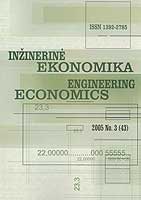The Problems of Identifying the Essential Business-to-Business E-Commerce Environment Components
The Problems of Identifying the Essential Business-to-Business E-Commerce Environment Components
Author(s): Tadas Šarapovas, Aurelijus CvilikasSubject(s): Economy
Published by: Kauno Technologijos Universitetas
Keywords: business-to-business electronic commerce; business environment; e-commerce environment.
Summary/Abstract: Electronic commerce is treated as one of the most efficient instruments for business processes optimization, based on more effective control of information flows. E-commerce infrastructure is that part of the total economic infrastructure that is needed to support e-commerce processes and to conduct electronic commerce transactions. It includes investment in computers, routers and other computer hardware; satellite, wire and optical communications and network channels; system and applications software. It also includes expenditure for support services, such as web site development and hosting, consulting, electronic payment and certification services as well as human capital, such as programmers. In essence, e-commerce is the secure trading of goods, information or services. Contrary to popular opinion, an e-commerce solution is not simply a single component, rather a collection of individual parts that together allow information exchange to take place across the electronic networks.The rapidity of e-commerce integration to economy shows that in the nearest future e-commerce will become the necessity for any and all business forms. E-commerce evolution is related to rapid perfection of information technologies, their growing possibilities of adoption in various areas and the cost of use decrease. The spread of e-commerce in various economy sectors is related to the modern business characteristics: huge and constantly growing competition, decreasing variety of competitive advantages, durable treatment of profit, as the result of cost reduction. As electronic commerce develops, it could have profound impacts on individual sectors of the economy as well as on macroeconomic performance and economic policies. Electronic commerce growth could have significant effects on the structure and functioning of economies at the firm, and industry level as well. These changes are likely to have influence on prices as well as the composition of trade, labour markets and taxation revenues. E-commerce integration to business processes is considered as realistic possibility to strengthen the company’s position in the market, so in near future it is very believable for e-commerce to become the necessity (market entrance barrier) in some industry sectors, where e-commerce models can generate considerable cost economy. In that case it can be concluded, that any company in a small and medium-sized business sector must evaluate possible benefits from e-commerce adoption in business processes. Traditional competitive advantages like modern technologies, low cost level or suitable geographical location become less significant because of globalization process. But before making decisions of e-commerce adoption in the company, it is important to define and assess the main aspects of e-commerce environment. The paper aims to analyze the problems of business-to-business e-commerce environment assessment and to identify the essential elements of this environment.
Journal: Engineering Economics
- Issue Year: 2006
- Issue No: 1 (46)
- Page Range: 74-82
- Page Count: 9
- Language: English

